Fall flowery goodness at Zilker Botanical Garden
For your Bloom Day viewing pleasure, how about a return visit to Zilker Botanical Garden? Colorful subtropical perennials surround the parking lot, giving visitors a nice blast of color as they walk in. Here’s ever-popular yellow bells (Tecoma stans), with the purple blooms of fall aster (Symphyotrichum oblongifolium) below, a beautiful fall combo for full sun.
A closer look, with what appears to be copper canyon daisy (Tagetes lemmonii) cosmos next to the fall aster.
Masses of red firecracker fern (Russelia rotundifolia) caught my eye, especially as framed by dramatic, tropical-looking leaves. Lush, water-loving plants are not my area of expertise, but maybe someone reading will know what those leaves are? Update: It’s Alocasia macrorhiza. (Thanks, Peter!)
I bet the local hummingbirds love the firecracker fern.
A small lily pond at the edge of the parking lot contains this Japanese lantern, which looks especially pretty with the yellow bells glowing behind it and pond-loving dwarf papyrus (Cyperus haspens) in front.
In the butterfly garden, toothleaf goldeneye (Viguiera dentata) mingles with a pale-flowered aster.
I grew skeleton-leaf goldeneye (Viguiera stenoloba) in my former garden but have never tried the toothleaf (V. dentata), sometimes called sunflower goldeneye. I suspect it may do OK in part shade, since I’ve seen it thriving in Tait Moring’s woodland garden. I should give it a try. Anyone know where I can find it for sale?
Pollinators like it too!
I’m joining Garden Bloggers Bloom Day with this post. For more Bloom Day posts from gardens around the world, visit May Dreams Gardens and check out the links in the comments.
All material © 2006-2015 by Pam Penick for Digging. Unauthorized reproduction prohibited.


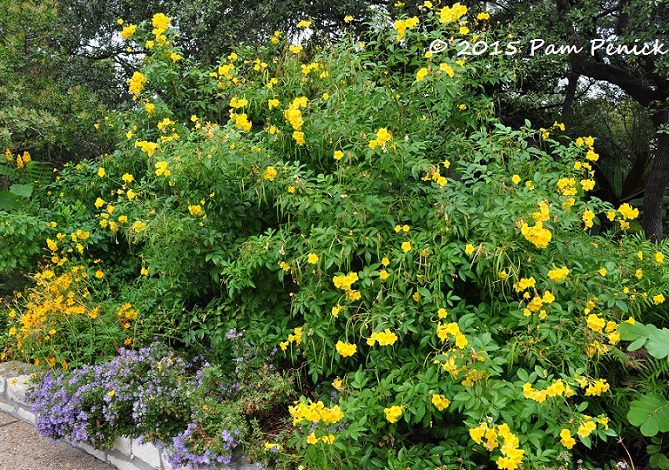
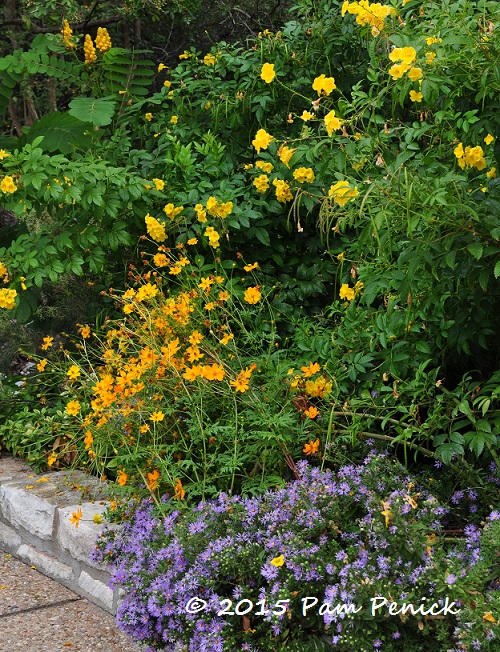
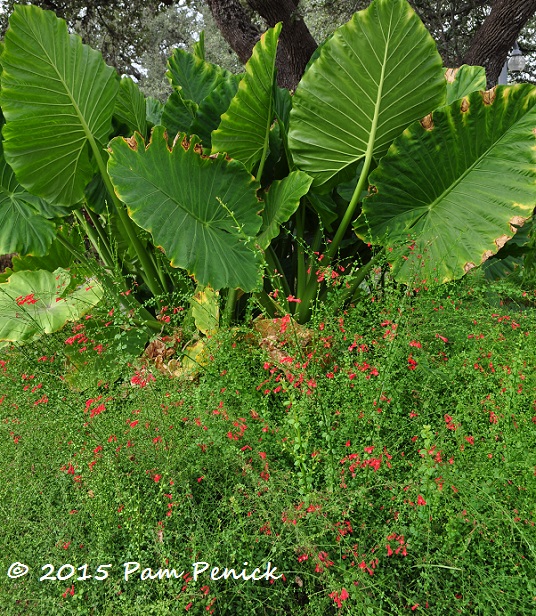
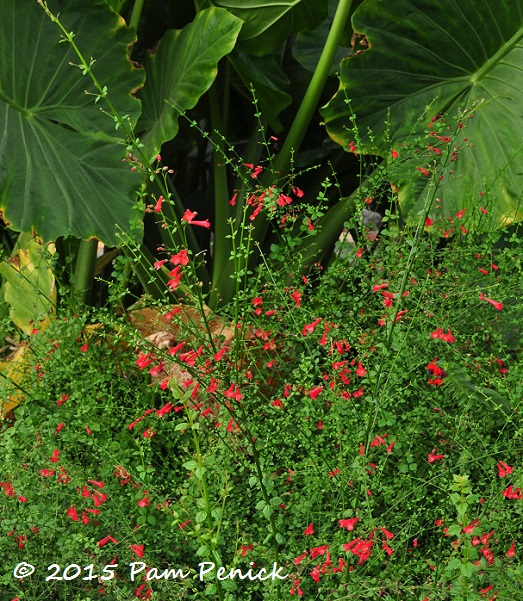
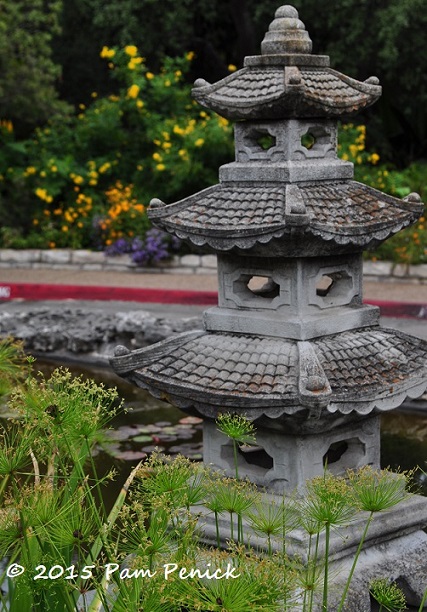
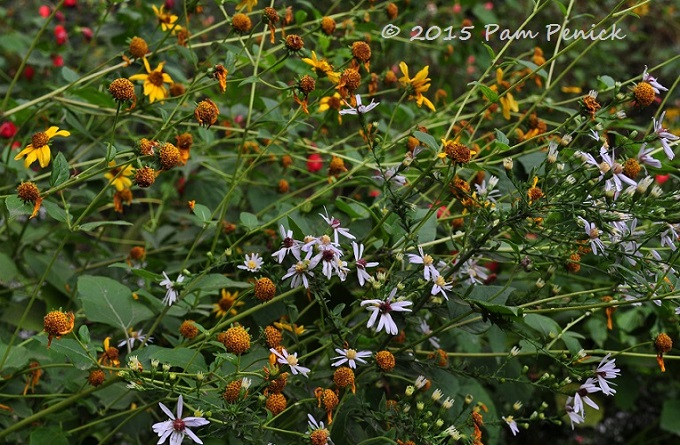
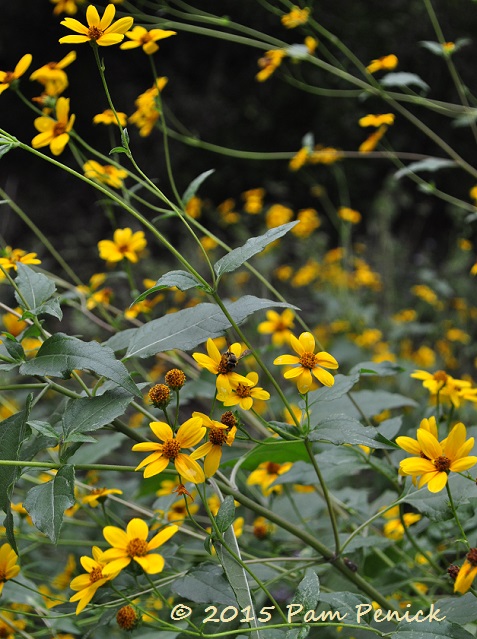
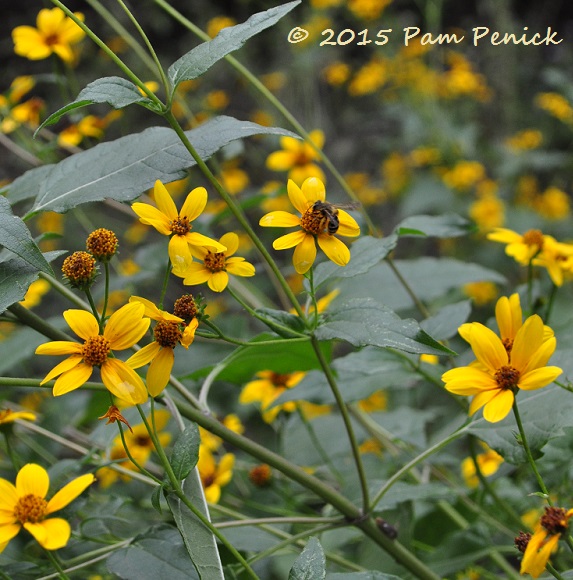
Oh my, all this color and green is so nice to see. It has become mostly brown here.
I’m glad you’re still reading (and commenting!), Lisa, even though gardening season is mostly over for you. It’s gotten very quiet here in blogland since Halloween. I get the feeling everyone’s attention has turned to the holidays. 🙂 —Pam
Hi Pam those are real residents here, i am from the Philippines, hot tropics! Being very common here, i don’t particularly love those red ones you call firecracker ferns. But those Tecoma stans are lovely lining some streets here. Those leaves are maybe a species of Alocasia, we have lots of them here and of different leaf sizes.
Thanks for taking a guess on the big-leaved plant, Andrea. Do you grow the orange and red varieties of the Tecoma stans? They are not as common here as the yellow, but they make a nice change. —Pam
I love the Tecoma/aster combination. I recently picked up a Tecoma stans at my local botanic garden’s fall sale – it’ll be interesting to see if it does as well here as it does in Austin.
I’ll be interested as well to see how it does for you, Kris. You have the summer heat it’ll want, plus plenty of sun. I think it should do well for you! —Pam
You can usually find goldeneye (v.dentata) for sale at the Wildflower Center’s fall sale. Once you have it you’ll have it forever because it is a prolific reseeder.
Do you grow it, Mary? And if so, do you have any idea how much shade it can tolerate and still bloom? —Pam
I do grow it. I started by giving it most of the day sun, but then it started choosing other places where it thought that it would be happy. One of those places gets mostly dappled shade for most of the day, and it still did fairly well. It bloomed fairly well, but not so as exuberantly as those in the sun do. It also stayed shorter (about 3 feet), which was okay with me because those in the sun can easily reach over my head.
Sounds adaptable. I’ll have to give it a try. —Pam
In the second photo, if you’ll look closer at the leaves, you’ll see the orange flowers are Cosmos sulphureus, not copper canyon daisy.
BTW, I love your posts – the photos are always well thought out and clear, and your writing is insightful. Keep up the GREAT work.
I did actually zoom in on those leaves and waffled over whether it was cosmos or copper canyon daisy before I posted. I must have had a brain lapse when I went with ccd because it’s clear to me now, from both leaf and flower, that it’s not ccd. 🙂 Thanks for setting me straight! —Pam
Great photos, Pam! The water loving combo is Alocasia macrorhiza and Russelia coccinea.
Thank you, Peter! I suspect this particular firecracker fern, which has rounded leaves, is sold under two names. I most often see it as Russelia rotundifolia, but I’ve also seen the name you gave, R. coccinea. Unless there’s a distinction that I’m not aware of, which is certainly possible. —Pam
No need to buy a sunflower goldeneye. You can easily find them growing in the wild. They propagate easily from seed or softwood cuttings or root cuttings.
Last year I plucked one up from a ditch in late summer, plopped it in the ground in part shade. It is 3ft by 3ft this year, and it has been blooming for 2 months.
In my opinion, copper canyon daisy is better for full sun, because it’s frost burnt foliage looks better in the winter. You have to cut this one to the ground. But this plant is preferable for shadier situations.
I certainly have the shade. My copper canyon daisy blooms but doesn’t get as much sun as it would like. I’ll have to try this one next year. —Pam